How to Paint the Mona Lisa in Three Easy Steps Funny
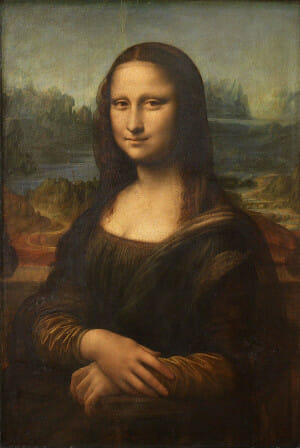
Original Mona Lisa painting in Louvre
A Master Painter's journey to recreate the most famous portrait painting in the world | a Study of Old Masters Oil Painting Techniques
This article documents my journey, process and struggle to recreate the Mona Lisa — the most famous portrait painting commission in the world. It is a study of classical realism, techniques, materials and methods of the old masters. We are going back in time 500 years, to delve into the mind of a genius … Leonardo da Vinci, and into the mystery surrounding one of the greatest art events in history.
Join me as we go back to the early 1500's and walk in the foot steps of the great master himself. We will explore the many fascinating facts about the work, the artist, the old masters painting process, the great heist, the Golden Ratio and much more!

Leonardo da Vinci
I'll be posting pictures of my work at various stages and describing details of my painting process and challenges along the way. The painting I'm creating is a commission for a client. Feel free to write comments and questions at the end of this article. I will respond.
If you're interested in commissioning a portrait, or just learning more about my portrait painting, check out Portrait Painting Commissions by Mark Lovett Studio.
Brief History of the Mona Lisa
Mona Lisa Portrait Painting Commission – A Master Painter's journey to recreate the most famous portrait painting in the world | a Study of Old Masters Oil Painting Techniques
Leonardo da Vinci's Mona Lisa painting, in the Louvre Museum in Paris, is arguably the most famous painting in the world. Painted by Leonardo in the early 1500's in oil on poplar wood, the original work is approximately 20 x 30″. There's been a lot of speculation about who the woman in the painting was. It's thought to be a portrait of Lisa Gherardini, wife of a Florentine cloth merchant called Francesco del Giocondo.
Art historians know Leonardo had begun the Mona Lisa by 1503, but when he finished it is less certain. The Louvre originally dated the painting to 1503-06, but discoveries made in 2012 suggest it may have been as much as a decade later before it was finished.
The more I study and learn the history surrounding the work and the artist, the more fascinating the project becomes. The history of the Mona Lisa is shrouded in mystery. Among the aspects which remain unclear are the exact identity of the sitter, who commissioned the portrait, how long Leonardo worked on the painting, how long he kept it, and how it came to be in the French royal collection. No less fascinating, in 1911 the Mona Lisa was the victim of the greatest art theft of the twentieth century by Vincenzo Peruggia.
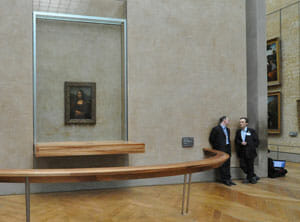
Mona Lisa hanging in the Louvre
The Mona Lisa Painting Project
I've been commissioned to paint a reproduction of this famous work for a client and I have just started the project. To avoid feeling overwhelmed, for now, I must keep it very simple. Baby steps. Basics. Take the first step forward. The drawing.
Our website was created by Affordable Small Business Website Design | Lovett Web Design.

Vermeer at work at the easel
Here I am hard at work on the drawing. Not! Just kidding that's not me. I wish I could grow hair like that!
To start, I need an appropriate support and I chose a very fine, uncradled, maple panel, custom made, 20 x 30″, gessoed, by Art Boards in New York.
Since I can't get to the Louvre to paint, or borrow the original from the Louvre, I had to settle on the next best thing. I accumulated various high quality digital files of the original, and I'm viewing the images on a large, very high quality computer monitor.

My Work – 1st session
Creating the Underpainting/Grisaille
Left, is the result of my first session. I applied a layer of thin, warm, umber oil paint on my 20 x 30″ gessoed maple panel.
Time to lay out the figure on my panel. Since my work will be framed, I have allowed about 3/4″ extra space around the image that the frame will cover.
On my white gessoed maple panel, I marked a few lines in pencil signifying where the major elements of the figure will reside. I didn't want to spend a lot of time creating a detailed pencil drawing that would only get covered with paint so I chose paint a warm, simple under-painting in fast drying, thin, umber oil paint.
My intent is to quickly cover the canvas with a thin, dry coat of paint reflecting where the basic forms live, indicating as accurately as possible light and dark values. I used no white paint at all, and used my fingers on occasion to work the paint in.
Of primary importance at this stage is to get the figure foundation positioned properly, capture a little bit of the likeness and block in light and dark values with a thin coat of fast drying, warm, umber paint. Can you see any similarity yet! Wow. I have a lot of work to do. Better get back in the studio.

My Work – 2nd session – face
Continuing the Under-Painting
My 2nd session, I finished the background umber under-painting laying out the basic shapes and values . For the first time, I opened the titanium white and added another thin layer to the face adjusting the position of the eyes, nose and mouth.
The face looks so cool here primarily because the rest of the painting is so warm. When the background gets cool in subsequent layers, the face will look much warmer, and I intend to warm the face more later.
It's now time to have a look at what is known about Leonardo's painting process.
Leonardo The Artist
Leonardo da Vinci (1452–1519) is one of the most intriguing personalities in the history of Western art. Trained in Florence as a painter and sculptor in the workshop of Andrea del Verrocchio (1435–1488), Leonardo is also celebrated for his scientific contributions. Leonardo's curiosity and insatiable hunger for knowledge never left him. He was constantly observing, experimenting, and inventing, and drawing was, for him, a tool for recording his investigation of nature. Although completed works by Leonardo are few, he left a large body of drawings (almost 2,500) that record his ideas, most still gathered into notebooks. He was principally active in Florence (1472–ca. 1482, 1500–1508) and Milan (ca. 1482–99, 1508–13), but spent the last years of his life in Rome (1513–16) and France(1516/17–1519), where he died. His genius as an artist and inventor continues to inspire artists and scientists alike centuries after his death. Leonardo's two most famous paintings are the Mona Lisa and the Last Supper.
Leonardo da Vinci Painting Technique
It is widely believed Leonardo da Vinci would first create a detailed underpainting orgrisaille in a neutral gray or brown, then apply his colors in transparent glazes on top. Some of the underpainting would show through the layers, subtly helping to create form. On his palette were muted, earthy browns, greens, and blues within a narrow tonal range. This helped give a sense of unity to the elements in the painting.

Leonardo da Vinci Notebook
Soft, gentle lighting was crucial to his paintings: "You should make your portrait at the hour of the fall of the evening when it is cloudy or misty, for the light then is perfect."Facial features were not strongly defined or outlined, but conveyed by soft, blended variations in tone and color. The further from the focus point of the painting, the darker and more monochromatic the shadows become.
Leonardo's technique of softening colors and edges with dark glazes is known as sfumato, from the Italian fumo, meaning smoke. It's as if all the edges have been obscured by a haze of transparent shadows, or smoke. Creating colors by applying glazes gives a painting a depth you cannot get by applying a color mixed on a palette. Or in his own words: "When a transparent color lies over another color differing from it, a compound color is composed which differs from each of the simple colors".
Leonardo explains color perspective this way, ". . . through variations in the air we are made aware of the different distances of various buildings. . . therefore make the first building. . . its own color; the next most distant make more blue. . . at another distance bluer yet and that which is five time more distant make five times more blue." This principle is demonstrated in the background of Mona Lisa : the ground and hills directly behind the subject are painted in warm tones of reddish browns and tans. As the landscape recedes the mountains and water become progressively more blue.

The back of the poplar panel original Mona Lisa
Leonardo also noted that air is more dense closest to the earth, therefore the bases of hills will always appear lighter than the summit; he applies this theory to the hills behind the sitter's shoulders which start out a tan color and become dark brown (Kemp, 83-84). His study of shadow can be related to his works in both compositional arrangement and insfumato** techniques, which are both demonstrated in the Mona Lisa . One method of composition employed by Leonardo involved focus and blur. In the Mona Lisa, Leonardo uses shadow in the lowest areas of the picture plane, at the edges, and background of the landscape to blur detail and draw attention to the detailed focus area of the face.
Leonardo also uses shadow as a primary element in creating sfumato or soft focus, which creates the illusion of volume by allowing light to emerge from the darkness of shadow. The sitter's body in Mona Lisa emerges from the shadows surrounding her from the mid arm area down. Her hands are areas of light that emerge form the blurred shadows of her body and her face emerges from darkly shadowed areas of hair and veiling.
Leonardo's study of the shape of shadow contributed to the blurred shadow edges that are a hallmark of the sfumato style. The Mona Lisa's body and face are enclosed within shadow, but no shadow edges ever become evident (Dunning, 82).
Old Master Technique Basics
The idea is to create the illusion of reality, which means showing few if any brush strokes. In practice this means following the application of brush strokes with blending into the existing paint on the surface. This can be done using another soft, dry brush or even with a finger or a paper towel. I often witnessed the great realist, Nelson Shanks, blend his brush strokes with Bounty (must be this brand according to Nelson due to it's softness) paper towels and sometimes with a finger.
Another key characteristic of painting in the style of the old realist masters, such as da Vinci, is using warm and cool colors to build the illusion of a three dimensional object on a flat surface. When a form turns, the colors change temperature. Generally the color get's cooler as it turns away from the light source into shadow.
For example, the light hits the top of Mona's nose, which creates a dark shadow under the tip of her nose, above her top lip. Where the nose starts to turn down at the tip, I apply a red tint, then below a slightly darker green tint , then below a darker brown tint in the darkest part of the shadow. As the shadow get's closer to the top lip it lightens and gets cooler with a greyish green tint. The form can actually go from warm to cool, to warm to cool, several times in the same form turn. If the values (lightness and darkness) are correct, and in the proper location, when the colors are slightly blended, the form looks very real and 3 dimensional.
To summarize, key characteristics of old master realism painting are:
- good drawing
- accurate placement of paint
- accurate values (light and dark)
- warm and cool colors to create the illusion of form
- minimize the appearance of brush strokes

Golden Spiral derived from the Phi's Fibonacci Sequence
Mona Lisa and the Golden Ratio: Phi 1.618
The intense presence of the portrait, as well as the experience of Mona Lisa's eyes following the viewer throughout the room is no accident.
What makes a single number so interesting that ancient Greeks, Renaissance artists, a 17th century astronomer and a 21st century novelist all would write about it?
This Golden Ratio truly is unique in its mathematical properties and pervasive in its appearance throughout nature. It is recognized that Leonardo Da Vinci used Phi, known in the 1500's as "The Divine Proportion," in a number of his paintings including Mona Lisa .
Where Pi or p (3.14…) is the ratio of the circumference of a circle to its diameter, Phi or Φ (1.618 …) is the Golden Ratio that results when a line is divided in one very special and unique way.
The Fibonacci sequence, also a plot element in "The Da Vinci Code," provides yet another way to derive Phi mathematically. The Perfect Rectangle is formed by creating rectangles within the corresponding dimensions of 1.618, from each descendingFibonacci Number (8, 5, 3, 2, 1, etc.) The spiral comes from touching each side in the Perfect Rectangle. The Golden Spiral can best be seen in the shell of a Nautilus.
Many years ago, I acquired a golden mean caliper to help me layout art in a manner that lives well within the Golden Ratio. It is very effective yielding consistently pleasing and interesting results. Notice the key points that the Golden Spiral, shown in the over-layed Mona Lisa image above, comes in contact with. It touches the bottom of the nose, the bottom of the chin, the top of the head, and at the intersection of the hands. The right eye touches the Golden Ratio line as well. All these key points in the figure corresponding to lines formed from the Golden Ratio mathematical formula yield an intensely compelling portrait. The viewer's eye comes in from the bottom left and runs naturally through the hands to the face to the right eye.

My Work – 3rd session-hands
Under-Painting: the Hands
This is my first paint layer using white paint in the mix on the hands. A rough outline was previously scrubbed in with burnt-umber only. In this pass, Im focused on carefully positioning the hands and introducing color.
I worked with yellow ochre, terra rosa, ultramarine blue and white, liberally applying paint with very little medium. The hands are far from completed, but I now have a good foundation to build. It is difficult to see my work in these zoomed out images, so as I get farther along, I will post close-ups.
If anyone reading this article has any questions for me, feel free to ask them in the comments section of this post below, and I will respond.

My Work – 4th session – hands, background etc
Major Progress
Major progress appears to have been made in this session. I worked a couple more hours on the hands, then the background, hair, face, chest and clothing, moving around the entire panel.
It's so nice to finally see the cool colors in the background and the work starting to come together so well! You can see the warm under-painting still peeking through in the sky.
My Palette
My palette consists of Vasari oil paint tubes in ultramarine blue, yellow ochre, burnt umber, terra rosa and titanium white. I work with thin layers of almost pure paint with very little medium.
I have dozens of paint colors but it's best to use restraint keeping the colors to a minimum which enhances color unity.
For medium, I use a Galkyd gel in a tube previously made by Daniel Smith, now available through Gamblin. I use this medium primarily to speed up drying time and add a little fluidity when needed.
Brush Selection
My brushes are made by Rosemary in England. I prefer the Masters Choice Long Flats made from mongoose and badger hair. The softness of these brushes offers the ability to lay down thick paint on top of an already thick stroke without digging into the lower stroke the way the stiffer hog bristle would. They're also great for softening edges and for detail work. I use sizes 2 – 12. For detail work I use the round golden synthetic 301 sizes 1-4. For more detailed info on the use and selection of brushes, Schultz article is a good resource.
Color and Value Selection
For fear of damaging the 500 year old paint, the Mona Lisa hangs in the Louvre unclean, and most likely has lost some of it's original color and brightness. Upon careful examination under light, many more details are revealed. A quick google search of the Mona Lisa yields a variety of different color temperatures, values and contrasts. For example, I see very warm images of the face as well as some very cool ones.
I also see faces that are dark with much shading, and some that are light with little shading. I see images where the hair is lighter red/brown and others where the hair is very dark almost black. I have a very high quality digital image of the original, but even that is subject to interpretation based on the color and intensity of the light on the image.
Soon I'll be arriving at the stage of my project where choices regarding color and value will need to be made. It is my desire to create a historically accurate representation of the original work, and it makes perfect sense to increase light values and color saturation a little bit.
Why is the Mona Lisa the most famous painting in the world?

After being stolen in 1911, group gathers around Mona Lisa when returned in 1914
The Great Theft
What really catapulted the small portrait to international stardom was a daring burglary over 100 years ago.
When Italian handyman Vincenzo Peruggia stole the Mona Lisa from the Louvre in 1911, her absence would be the very thing that made her the most recognizable painting on the planet.
Suddenly images of the artwork were splashed across international newspapers, as the two-year police hunt hit dead-end after dead-end.
It wasn't until December 1913 that Peruggia was finally caught and the Mona Lisa recovered, becoming the most well known painting in the world. "If a different one of Leonardo's works had been stolen, then that would have been the most famous work in the world — not the Mona Lisa," said Noah Charney, professor of art history and author of "The Thefts of the Mona Lisa."
"There was nothing that really distinguished it per se, other than it was a very good work by a very famous artist — that's until it was stolen," he added. "The theft is what really skyrocketed its appeal and made it a household name." So how did Peruggia pull off one of the greatest art heists of all time? The handyman had been hired by the Louvre to make protective glass cases for some its famous works — including the Mona Lisa.
After hiding in a closet overnight, he simply removed the painting, hid it under his smock, and was about to waltz out of the building when he discovered the door was locked. Desperate Peruggia removed the doorknob, but still it wouldn't open — until a helpful plumber passing by opened the door with his key. It was 24 hours before anyone even noticed the Mona Lisa was missing, with artworks often removed to be photographed or cleaned.
"The Louvre had over 400 rooms but only 200 guards and even fewer on duty overnight," said Charney, founder of the Association for Research into Crimes against Art (ARCA). "There were basically no alarms in play." "It was under-secure. But to be fair, most museums were at that time."
The French press had a field day, seeing it as an opportunity to poke fun at the seemingly inept government which ran the Louvre. This was an era where newspapers were really taking off, and pretty soon the theft — and the image of the Mona Lisa — was splashed across the world. "60 detectives seek stolen Mona Lisa, French public indignant," reported the New York Times.
For the first time there were queues outside the Louvre, just to see the empty space where the painting had hung. "The theft launched it into becoming a household name for people who had never been to Europe and had no interest in art," said Charney, adding: "And it's really just continued from there."
Over the next two years, the bungling police investigation dragged on, with Pablo Picasso a suspect at one point. The force even interviewed Peruggia twice, before concluding he couldn't possibly be the man behind the brazen burglary. The head of the Paris police retired in shame. And then two years later, an art dealer in Florence received a letter from a man saying he had the Mona Lisa. It was signed "Leonardo." The man was of course Peruggia.
After setting up a meeting with the dealer and the director of the Uffizi gallery in Florence, Peruggia turned up with the painting which had spent years hidden in a trunk in his apartment. Peruggia, then 32 years old, claimed to have stolen the artwork to return her to her native Italy. He was arrested and eventually sentenced to seven months jail.
"He seemed to have genuinely been convinced he would be heralded as a national hero and genuinely dismayed to discover he wasn't," said Charney, adding: "He was maybe a few pickles short of a sandwich, but not a lunatic." For most of us, the Mona Lisa will only ever be seen from behind bullet-proof glass, a thumbnail in the distance, smiling her knowing-smile behind jostling tourists with camera phones held aloft.
But for over two years Peruggia had the famous woman all to himself. Did he fall in love with her? "I think so," said Charney. "There are a number of thieves who have stolen art and have suffered a sort of 'reverse Stockholm syndrome' — where the hostage-taker falls in love with the hostage." "In this case, the hostage was a work of art."

Mona Lisa being returned to it's home in the louvre in Paris after WW2

My Work – 5th session – below chest
Baby Steps
Sometimes a session seems to yield very little, but that's ok. Just keep moving forward! I focused on the sleeve area and below. Even tweaked the hands a bit more.

My Work – 6th session – sleeves, tunic, chest, bg
Moving Forward
It's difficult to see much progress in the last three sessions in these images that I've posted. I'll zoom in later and much more will be evident. In any case, the initial layout stages show dramatic changes in each session, and as we progress into details the changes are less evident in each session.
It is imperative to have the foundation laid properly or the subsequent detail layers will be fruitless. I am careful to double check the basic positioning of each element before each detail layer is added.
Every brush stroke I make now is still a foundation for the finish brush strokes to follow in the final layers. So I continue to use thin paint as I build form. Everything, except the foundation is subject to change, in a state of flux as I proceed.
I'm really looking forward to my next layer on the face and refining the background. I believe it will be a noticeable improvement.

My Work – 7th session – refining face and bg
Coming To Life
The gregorian chant music sets the mood in my studio. Sipping my freshly ground, full bodied coffee, adrenaline pumping, filled with excitement about what's to come, I ask myself, what would Leonardo do?
Laying out fresh paints for my session, I carefully study the original mona lisa image and then study my painting. How do I make my painting come to life?
I feel like I'm channelling Leonardo right now!
I start with an obvious needed correction on the right pupil. As I work, and refine, the differences become less obvious. I squint down, glance at the original mona lisa image, then glance at my painting, repeating the process several times, then make several brush strokes. The last stroke seems to cool, so I warm the paint on my palette and apply another stroke on top of the previous brush stroke. That's better.
I'm always tweaking the foundation where needed as Im adding details. If you closely compare this session image with the last session image you will notice that the right pupil was a bit too far too the right and the neck was a bit too long. After making those corrections, I continued to touch up the eyes, nose and mouth, refined the hair where it meets the chest, and the background area surrounding her hair.
I walk about 10 feet away from my painting, squinting down a bit, glancing back and forth between the original and my work, repeating the process several times, and laying a few more brush strokes. Yes! It's coming to life.
Mona Lisa is starting to come alive!

My Work – 8th session – warming and refining face
Warming Up
I refined the face, warmed it, and adding reflected light under the chin. Now that I have all the elements positioned correctly, the values relating to each other properly, and have a good likeness, I'm ready to start working on the finishing layers.
I've been reluctant to go as dark as the original on the background in the sky and area surrounding the face, as well as shading on the face. However, after pondering this matter, I have decided to go darker as the original appears to be because I believe it will look more authentic if I do so.

My Work – 9th session – refining face & background
Refining, and more refining
I glazed the lower background with Gamblin transparent red and darkened the upper background with a green hint. More shading was added to the face. The sky was darkened towards the top and lightened near the horizon using some warm and cool colors.
Soon, I will zoom in and compare more closely with the original.

My Work – 10th session
My 10th Painting Session
In order to compare values more closely, I compared a desaturated black and white picture of the original to a desaturated black and white picture of my painting. This was instrumental in determining where I still needed work. I noticed that the face still needed more shading, the background needs to be darker, the hands needed more shading, and I also noticed that the color of the hands was a little too yellow in comparison to the face. These items became a part of my to-do list, and I began chipping away at them as best I could one at a time.

My Work – 11th session
My 11th Painting Session
Determined more than ever to make great strides, I once again set aside a large block of time …… 3pm till 11:30pm ! With a large pot of my favorite full bodied coffee ready to go, I entered my studio with great energy and focus. With my Gregorian chants setting the mood, I laid out plenty of fresh paint and a new roll of paper towels (you should see the mess I make). With my to-do list in the back of my mind, glancing back and forth between my painting on the easel and the original image on my computer monitor, I walked back about 10 feet and squinted down.
Initially I was tentative to make a stroke. When near completion, sometimes it's one step forward and two steps back! Hard work doesnt always yield improved results! So I try to start on the most glaring issue. Asking God to guide my hands, I brushed some medium on the face, and immediately noticed an edge that needed softening. Boom ….With adrenaline pumping , I was off to the races. First tweeking the left eye, then to shading on the cheeks, the chin, then to the neck, then worked on how the hair falls onto the chest, then to creating form on the chest…….
Moving back, squinting down, moving close, moving back ….. It seemed like a couple of hours had passed, and I was exhausted. I looked at the clock …. it was 11pm. I had been working standing up the entire time for about eight hours! No wonder I'm so tired. Im not 25 anymore! My gosh I still havent done anything to darken the background as I intended. Knowing that I didnt have the time or energy to complete the sky background, I still decided that I would lay a foundation. I laid out some gorgeous fresh ultramarine blue paint and began quickly creating various mixtures of blue, white, umbers, and ochers. These are all colors that I noticed in the original. I worked on the sky for another 30 minutes and although not complete, I stopped working and started cleaning my mess. I had no energy left.
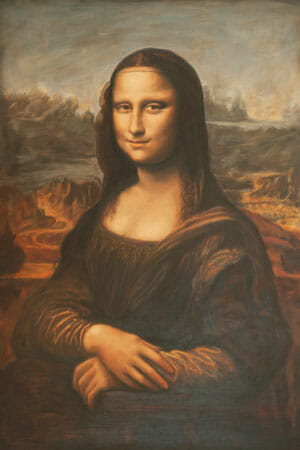
My Work – 11th session – zoomed in
My 11th Painting Session Zoomed In
The next morning, I assess the 8+ hours work I did from the previous day, and take a picture, post it on my blog, and start writing about my experience. The end is near. I see the sky still needs work, but I'm about ready to sign it, varnish it, say goodbye, and send my Mona Lisa to it's new home.
Thank you to all that have left comments on this article. I'm going to take a few minutes to respond right now.
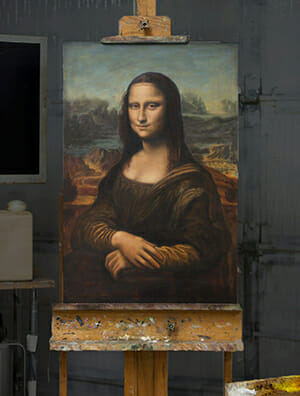
My Work – 12th session
My Brushes Are Calling Me
My wife suggested I take the night off and play some guitar. I had every intention of doing so, but my brushes started calling me! It has been several days since I painted, and I wanted to do some work on the sky, and I just couldnt resist.
A large cup of full bodied coffee in my left hand, and a fistful of chocolate in my right, I descend into my man cave. My choice of mood music tonight is yet again Gregorian chant.
I lay out a few gorgeous, buttery, oil paints on my over-sized palette, put a little Vaseline on my hands so paint wipes off easily, stand back, and compare my work with Leonardo's. My best intentions are to start with the sky, but Mona's eyes are now calling me. I look closely at the edges, the interplay of warm and cool colors creating form. I can do better. I focus my attention only on the eyes and ask myself how Leonardo's differ. Discovering ways to improve, I begin, trying to capture the subtle nuances, that make the famous 'Mona Lisa eyes'.
Helpful words come to me that I first heard from the late great classical realist painter, Nelson Shanks , when I studied figure and portraiture painting years ago at Studio Incamminati in Philadelphia. Nelson used to say, "To create form, paint planes with contrasting warm and cool colors using the appropriate values". I am very thankful that Nelson taught me the importance of first 'seeing' the subtle nuances of form before trying to express them in paint.
A flurry of concentrated effort yields improvement, so I move to the back of the room, close my eyes, then open them once again. Yes. That's it! On to the sky!
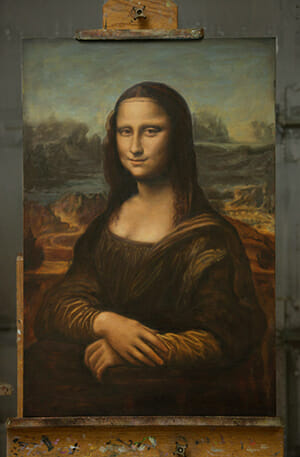
My Work – 12th session -zoomed
Not So Fast
Neck shadow …. a little longer, a bit softer. The chest …. more roundness ….. working in the subtle shadows, then working in some warm light paint on the top. Yes! Now it's on to the sky!
I see light warm ochres, and cool ultramarine blues in the original. Starting with the edges of the mountains in the distance, moving down adding darks, then moving up in the light, mixing warm and cool colors, keeping the paint on the brush dry and minimal, I try and recreate the technique I see in the original. Using my badger hair long flat brushes of many sizes, I begin lightly laying paint in the sky.
Noticing few brush strokes visible in the original, I experiment with applying paint with a paper towel and then massage it in with a large dry brush. Very nice! The ocher and blue paint mix together on the panel as I apply it to create green in various areas. Much better!
I'm happy with my work on the eyes, sky and chest. It's been several hours since I started this session and my energy begins to subside. That's a wrap!
I take a photo of my work on the easel under very cool artificial light in my studio, load it on my site, and begin writing about my experience.
In the many photos that I've taken during the process of painting this project, you'll notice quite a bit of variation in temperature. Sometimes the pictures of my painting look warm, sometimes cool, sometimes dark and other times light. Sorry about that! This is due to inconsistent camera settings and lighting.
Sooo close to being finished with my painting, exhausted, and going to bed. Good night….
Ah …. but a new dawn brings a new, never ending, list of development ideas for the work! Is it time to end this journey and begin a new one?
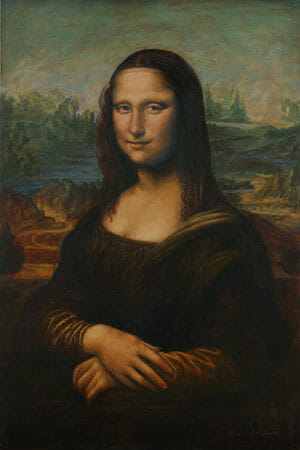
My_Work_Finish
The Finish
There were several more sessions after session 12 above that I didn't post. Just tweaking and tweaking!
"Painting the Mona Lisa – Project" has been an amazing, humbling, experience and I appreciate the opportunity that was given to me by my client (and now good friend) for commissioning the work.
Not only has this been a tremendous learning experience and improved my artist skills considerably, it has brought me back in touch with me. I came face to face with my obsession for the unobtainable …… perfection. I know, in my humanity, perfection doesn't exist, and longing for it can be torturous.
I have arrived at the conclusion that striving for perfection is a great thing …. if I'm enjoying the process (which I usually do). However, the challenge lies in knowing when it's time to turn it off, accept my imperfection, let go, and move on. Most artists will agree that is easier said then done! A little OCD can kick in and spoil the journey.
A common question that arises for most artists at some point in their journey is "How do you know when a painting is finished?" Another words, "How do you know when it's time to let go, accept, and move on?"
I am developing a short list of my own ideas on this topic below. If any of you reading this article would care to add any to the list from your own experience, feel free to do so in a comment at the end of this article. I'm sure the list will get real long, very fast and maybe it's best to keep it short and sweet.
My top reasons to stop painting (or turn off the OCD) :
- After a another long painting session, my wife can't tell any difference!
- It's not fun anymore. I start getting frustrated or even worse …. angry!
- The painting is starting to lose that fresh look

My_Work_Finish
Closing Thoughts
A New Respect for da Vinci
After spending countless hours over the course of the last few months studying da Vinci's Mona Lisa and attempting to recreate his work, I have gained a new respect and admiration for this work and the man who created it.
Upon close inspection of his work, it immediately becomes apparent that to create the many complex form transitions in the painting, it would require multiple accurate layers of paint, one on top of the other.
Da Vinci is thought to have worked on the painting off and on for a period of two to ten years, depending on which historian you talk to.
This fact makes me feel a little better because perhaps then I can lower my expectations of my own work because I only had a couple of months to work on it. Truth be told, I would not want to compete with Leonardo even if I had ten years to work on it! He is that good. It is much more difficult than it looks. His work truly is a masterpiece, and is deserving of the respect it gets.
Cracks and More Cracks
The original 'Mona Lisa' surface is completely covered with small cracks due to the 500 year age of the painting, the expanding and contracting of the poplar wood surface, and painting multiple thin layers one on top of another.
One of the drawbacks of painting form with high realism is that it requires multiple layers of thin paint, and painting in this style has the potential to check (or crack) in the future.
Challenges of Creating a Master Painting Reproduction
It has been a rare occasion in my career that I created a painting using an existing painting by another artist as the reference for my work. Many unique challenges arise. Perhaps at the top of the list is not having the original reference painting in my studio as I work. This introduces many variables which can be confusing at times. There is a huge difference in art appearance displayed among various computer screens. Settings, such as brightness, color balance and contrast are all over the map and create huge discrepancies in appearance.
The light in which a painting is viewed plays a huge part in the appearance of the work. On many occasions, I have viewed a painting in progress in a particular light ….. could have been window, fluorescent or even incandescent (the brightness and angle of the light has great effect as well). Upon seeing the work, I made some assumptions. The next time I viewed the work, the light on the painting was different, and my previous assumptions seemed to be incorrect.
A preconceived notion, by the public about what our work is supposed to look like, is a challenge artists don't usually face when creating our own work. It removes much of the creative aspect and sets us on the impossible task of creating a complex handmade work of art identical to another complex handmade work of art. I can see how most artists would repel at the thought.
When I ponder this topic in a different light (much as I do my paintings), I come to a more appealing conclusion. Of course, it must not be expected that the recreation is identical to the original. The client must be happy with a 'similar' painting, and appreciate our own individuality as artists as well. If this understanding exists, as an artist, I can certainly enjoy the journey of creating art that will make someone very happy; so it can be a rewarding experience for both parties.
Demand for Master Painting Reproduction
In museums throughout the world, people stand in line everyday to view famous paintings on display by master artists of the past. These paintings are valued at millions of dollars to hundreds of millions. Some are valued highly for the wrong reasons ….. such as a wealthy collector's corrupt influence over the museum. However, many are truly genius works of art ….. incredible compositions and brilliant brush work!
It makes sense that an art enthusiast would have a strong desire to have a famous, original, museum, master painting hanging on the wall in their own home. I can also understand why a printed copy of the painting would not be appealing.
Master Painting Reproduction as an Investment
If a talented artist can hand paint a similar painting (for thousands, instead of millions of dollars) which would substantially capture the qualities of the original, this is the next best thing to owning the original. It is a good investment as well because there will always be a high demand for a master painting similar to a famous multi-million dollar master painting in a museum.
The picture at bottom of page is Mark Lovett's finished painting commission, 'the Mona Lisa', exact same size as original in the Louvre, framed, lit, and hanging on clients wall. The painting on the far left is an original oil by Mark as well.
Thanks for joining me on this portrait painting commission journey. I hope you enjoyed it as much as I did!
Check out my recent oil painting portrait commission for a Chevy Chase,MD couple. The painting captured a special moment from their wedding day and was a surprise anniversary gift to his wife. I included some images and information regarding the old masters oil painting process I used to achieve the desired result. I'm sure some of the Mona Lisa Technique was applied as well.
Until next time…

Finished Mona Lisa Painting Commission hanging in clients home
'Painting the Mona Lisa like Leonardo' article
by Mark Lovett
Source: https://www.marklovettstudio.com/painting-the-mona-lisa-commission/
Post a Comment for "How to Paint the Mona Lisa in Three Easy Steps Funny"